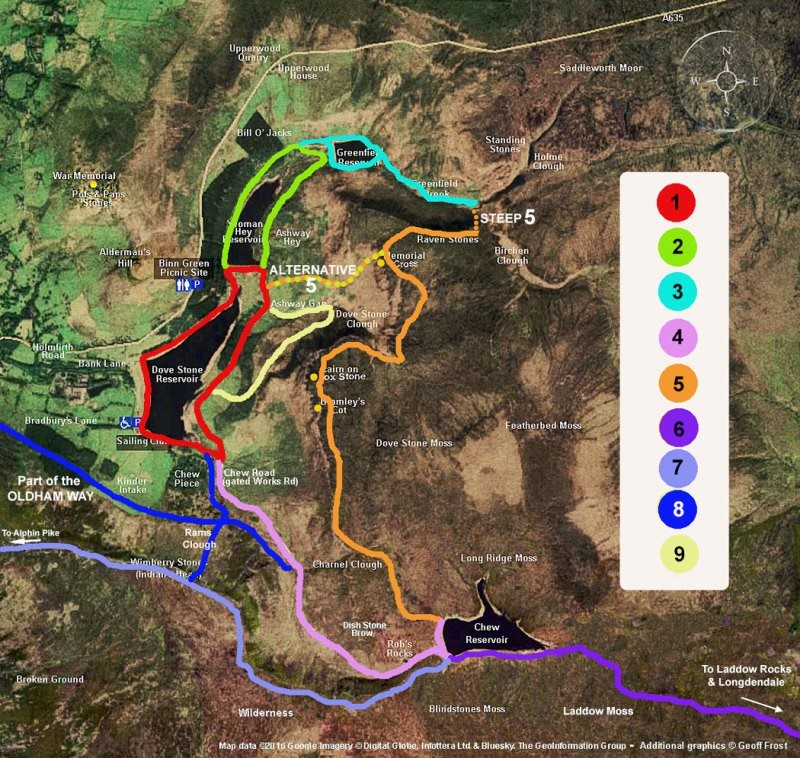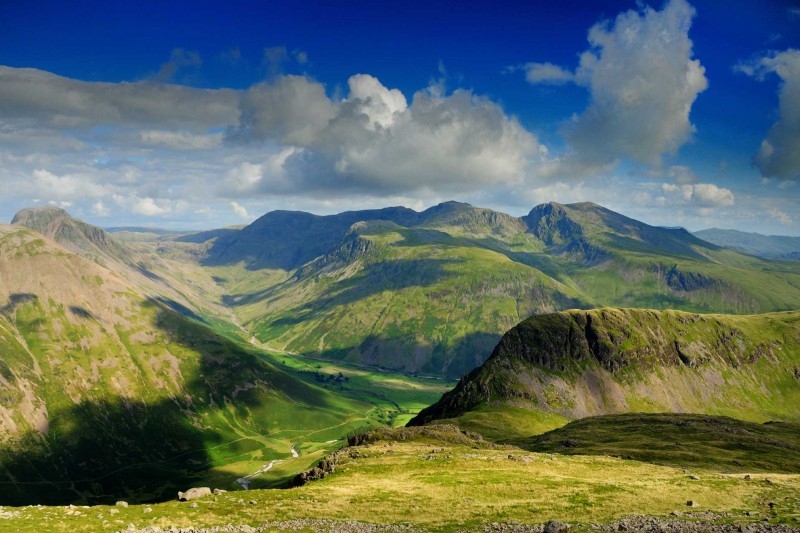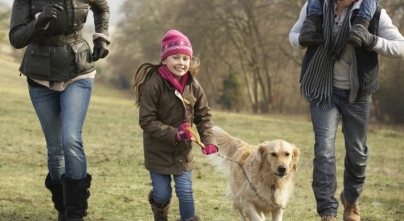A Walkers Paradise
The Peak District National Park offers a spectacular variety of scenery for walking and rambling routes – from limestone dales to dramatic high moorlands.
Local Walks
There are walks to suit individuals, families and groups. Whether you want a challenging hike or a short stroll, you'll find it here. Dovestone Reservoir itself is a popular location, providing a circular walk of 2.5miles with stunning views and giving access to two further reservoirs, Greenfield and Yeoman Hey to the north.
For your convenience, we have also planned out 9 local walks in the immediate locality, ranging across varying distances and challenges, taking in Dovestone, Greenfield, Yeoman and Chew reservoirs (more details are within your holiday park information pack within in your accommodation).

Famous Moor Trails
Here are details of some of the well-known trails, the two closest of which are Marsden Moor and Bleaklow.
Marsden Moor
A trail where you follow in the footsteps of Mesolithic men and women. Imagine yourself 11,000 years back in time and then relate to more recent times, with Blind Jack of Knaresborough building the turnpike roads.
Bleaklow
Bleaklow is very much for the adventurous and experienced walker and is an enhanced audio experience (creative writing and actors used). The trail showcases the restoration work of the Moors for the Future partnership.
Kinder
The adventurous walk that takes in the most famous landmark in the Peak District, with panoramic views from many points on the plateau.
Edale
The Audio for the Edale walk includes expert interviews and music. Edale with its remote rural railway station is where the Pennine Way commences and where a substantial Tourist Information Centre is located.
Audio Trails - There are a series of more than a dozen Audio Trails provided simply follow the link to ‘Audio Trails’.
Access to the Moors
Since the Countryside and Rights of Way Act (2000), walkers now have the right to walk at will on any of the moorland areas, regardless of whether they are privately owned. The only exceptions are when the moors are being used for shooting (for which prior notice must be given to cause an official closure), or when the moors are closed because of a high fire risk. Dogs must be on a lead during nesting time between 1st March to 31st July and under strict control outside these times. If you are thinking of walking on the moors, you should be competent in hillcraft and map/compass (or personal sat nav) techniques.
Respect the Countryside

The full details of the Countryside Code can be found at www.gov.uk/government/publications/the-countryside-code . We've outlined what we consider to be the most important issues although, in fairness, it's mainly just common sense and politeness:
- Work with the landowner (who is not necessarily a farmer), after all, it is their land. In particular, shut all gates that you pass through, do not block access whilst parking your car and try, wherever possible, to stick to the path. Do not climb over dry stone walls - they are a vital part of our landscape.
- Leave no trace of your visit and take your litter home.
- Do not light fires/drop cigarettes.
- Check the weather forecast before you leave and pack clothes accordingly. Also, take plenty of water and snacks in case the walk takes longer than it should.
- You may have a time target for a walk but if you take longer…so what. Do not ruin a walk by clock watching, just make sure you have plenty of water/snacks.
- Keep dogs under effective control. The key here is ‘effective control’. If your dog may chase animals (sheep in particular), keep it on a lead. If not, make sure it sticks close to you when sheep are nearby
The Peak District National Park offers a spectacular variety of scenery for walking and rambling routes – from limestone dales to dramatic high moorlands.
Local Walks
There are walks to suit individuals, families and groups. Whether you want a challenging hike or a short stroll, you'll find it here. Dovestone Reservoir itself is a popular location, providing a circular walk of 2.5miles with stunning views and giving access to two further reservoirs, Greenfield and Yeoman Hey to the north.
For your convenience, we have also planned out 9 local walks in the immediate locality, ranging across varying distances and challenges, taking in Dovestone, Greenfield, Yeoman and Chew reservoirs (more details are within your holiday park information pack within in your accommodation).

Famous Moor Trails
Here are details of some of the well-known trails, the two closest of which are Marsden Moor and Bleaklow.
Marsden Moor
A trail where you follow in the footsteps of Mesolithic men and women. Imagine yourself 11,000 years back in time and then relate to more recent times, with Blind Jack of Knaresborough building the turnpike roads.
Bleaklow
Bleaklow is very much for the adventurous and experienced walker and is an enhanced audio experience (creative writing and actors used). The trail showcases the restoration work of the Moors for the Future partnership.
Kinder
The adventurous walk that takes in the most famous landmark in the Peak District, with panoramic views from many points on the plateau.
Edale
The Audio for the Edale walk includes expert interviews and music. Edale with its remote rural railway station is where the Pennine Way commences and where a substantial Tourist Information Centre is located.
Audio Trails - There are a series of more than a dozen Audio Trails provided simply follow the link to ‘Audio Trails’.
Access to the Moors
Since the Countryside and Rights of Way Act (2000), walkers now have the right to walk at will on any of the moorland areas, regardless of whether they are privately owned. The only exceptions are when the moors are being used for shooting (for which prior notice must be given to cause an official closure), or when the moors are closed because of a high fire risk. Dogs must be on a lead during nesting time between 1st March to 31st July and under strict control outside these times. If you are thinking of walking on the moors, you should be competent in hillcraft and map/compass (or personal sat nav) techniques.
Respect the Countryside

The full details of the Countryside Code can be found at www.gov.uk/government/publications/the-countryside-code . We've outlined what we consider to be the most important issues although, in fairness, it's mainly just common sense and politeness:
- Work with the landowner (who is not necessarily a farmer), after all, it is their land. In particular, shut all gates that you pass through, do not block access whilst parking your car and try, wherever possible, to stick to the path. Do not climb over dry stone walls - they are a vital part of our landscape.
- Leave no trace of your visit and take your litter home.
- Do not light fires/drop cigarettes.
- Check the weather forecast before you leave and pack clothes accordingly. Also, take plenty of water and snacks in case the walk takes longer than it should.
- You may have a time target for a walk but if you take longer…so what. Do not ruin a walk by clock watching, just make sure you have plenty of water/snacks.
- Keep dogs under effective control. The key here is ‘effective control’. If your dog may chase animals (sheep in particular), keep it on a lead. If not, make sure it sticks close to you when sheep are nearby
